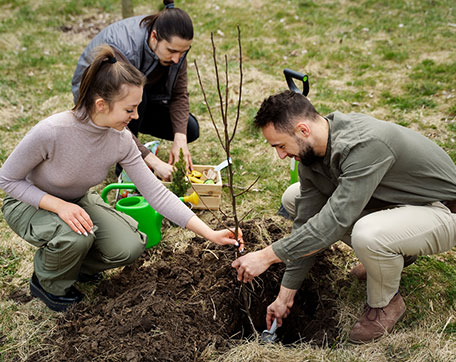



Non Timber Forest Products

NTFPs are Non-Timber Forest Products, comprising various goods like fruits, nuts, medicinal plants, etc., sourced sustainably from forests.
What is NTFP?
NTFP stands for "Non-Timber Forest Products." These are resources, goods, and materials that are obtained from forests other than timber. NTFPs can include a wide range of products such as fruits, nuts, mushrooms, medicinal plants, resins, fibers, and decorative plants, among others. They are often harvested sustainably by local communities and indigenous peoples and play important economic, cultural, and ecological roles in many regions around the world.

Robert Joe Kerry
Founder

Carbon Offsetting
80%Water Conservation
90%E-Waste Recycling
70%Socio-economic importance of NTFP
The socio-economic importance of NTFPs lies in their role in providing livelihoods, income diversification, food security, cultural preservation, and biodiversity conservation, particularly for forest-dependent communities.
Healthcare
Some NTFPs possess medicinal properties and are used in traditional medicine systems, providing healthcare solutions, especially in regions with limited access to modern medical facilities. facilitators in the areas we work.

Food Security
NTFPs contribute to food security by providing nutritious foods such as fruits, nuts, and edible plants, especially during times of food scarcity or agricultural off-seasons.

Biodiversity Conservation
ustainable harvesting and management of NTFPs can promote biodiversity conservation by maintaining the integrity of forest ecosystems and preserving habitats for various plant and animal species.

Value Addition and Processing
Value addition through processing and product development can enhance the economic viability of NTFPs, creating opportunities for small-scale enterprises and value chains that add value while ensuring sustainability.

- what we do what we do what we do what we do what we do what we do what we do
NTFP stands for "Non-Timber Forest Products." These are resources, goods, and materials that are obtained from forests other than timber. NTFPs can include a wide range of products such as fruits, nuts, mushrooms, medicinal plants, resins, fibers, and decorative plants, among others. They are often harvested sustainably by local communities and indigenous peoples and play important economic, cultural, and ecological roles in many regions around the world.
The socio-economic importance of NTFPs lies in their role in providing livelihoods, income diversification, food security, cultural preservation, and biodiversity conservation, particularly for forest-dependent communities.
Non-Timber Forest Products (NTFPs) encompass various resources harvested from forests, including food, medicine, craft materials, and more, supporting livelihoods and biodiversity conservation.
Identifying Non-Timber Forest Products (NTFPs) involves understanding local flora/fauna, recognizing characteristics like edibility, medicinal properties, and commercial value. Training, field guides, and consultation with experts aid in accurate identification.

Our Trees Have Been Monitored

Trees Planted
6,472,068

Trees Planted
6,472,068

Trees Planted
6,472,068

OUR CASE STUDY
Importance Of Jungal
Non-Timber Forest Products (NTFPs) play a crucial role in the socio-economic fabric of jungle ecosystems. The importance of jungle NTFPs lies in their multifaceted contributions to both local communities and broader environmental sustainability. These products, ranging from medicinal plants to fruits and fibers, are not only sources of livelihood for forest-dwelling populations but also essential for cultural practices deeply intertwined with the jungle's biodiversity. Jungle NTFPs provide a sustainable means of income diversification, particularly significant in regions where alternative economic opportunities are limited. Moreover, they contribute to food security, as many jungle NTFPs are nutritious and readily available, ensuring sustenance for communities in remote areas. Beyond their economic and nutritional value, these products hold immense ecological importance, supporting biodiversity conservation and maintaining the delicate balance of jungle ecosystems. By promoting sustainable harvesting practices and recognizing the intrinsic value of jungle NTFPs, we can foster not only local livelihoods but also the long-term health and resilience of jungal
Harvesting Calendar
Tree planting is the act of planting young trees, shrubs, or other woody plants into the ground to establish new forests or enhance existing ones. It is a crucial component of environmental
Personal Attributes of NTFP Harvesters/Collectors:
possess a range of personal attributes, including knowledge of local ecosystems and species, harvesting techniques, and traditional practices. They should also demonstrate patience, attention to detail, respect for nature, and a commitment to sustainable resource management. Additionally, physical fitness and the ability to navigate challenging terrain are important for effective harvesting in forest environments.
Permitted Areas Identification
efore harvesting NTFPs, it's essential to identify and access permitted areas where harvesting is legally allowed. This may involve obtaining permits or permissions from relevant authorities, such as government agencies, forest departments, or community organizations. Harvesters should familiarize themselves with regulations, zoning restrictions, and protected areas to ensure compliance and avoid illegal harvesting practices that can harm ecosystems and lead to legal consequences.
Fundraising Causes Need For Future

Foresty Loves People

Jhon Abraham
Marketing Managerposuere luctus orci. Donec vitae mattis quam, vitae tempor arcu. Aenean non odio porttitor, convallis erat sit amet, facilisis velit. Nulla ornare convallis

Jhon Abraham
Marketing Managerposuere luctus orci. Donec vitae mattis quam, vitae tempor arcu. Aenean non odio porttitor, convallis erat sit amet, facilisis velit. Nulla ornare convallis

Jhon Abraham
Marketing Managerposuere luctus orci. Donec vitae mattis quam, vitae tempor arcu. Aenean non odio porttitor, convallis erat sit amet, facilisis velit. Nulla ornare convallis
Foresty Awesome Team
Get News From Foresty
Guide Dog Shortage: The Blind People Who Train Their
Foresty Guide Shortage Blind People Train Daily Star News Published On Feb 2nd, 2022, Sangbad Protidin Dated…
By admin 0 Comment
Proin Ultricies Ultricies Est Vitae Cursus. Nul Sit Amet
Foresty Guide Shortage Blind People Train Daily Star News Published On Feb 2nd, 2022, Sangbad Protidin Dated…
By admin 0 Comment
There Are Also Natural Sources Of Methane – From
Foresty Guide Shortage Blind People Train Daily Star News Published On Feb 2nd, 2022, Sangbad Protidin Dated…
By admin 0 Comment
About Apna Jangal
Empowering forest-dependent communities in Jammu and Kashmir through technology and sustainable practices for equitable livelihoods and conservation.
Get In Touch!
- India : Kudlu Gate, Bangalore 560068 India
- (406) 555-0120
- Info@apnajangal.Com
Quick Link
Recent Posts
© Copyright 2023 Apna Jangal All Rights Reserved











